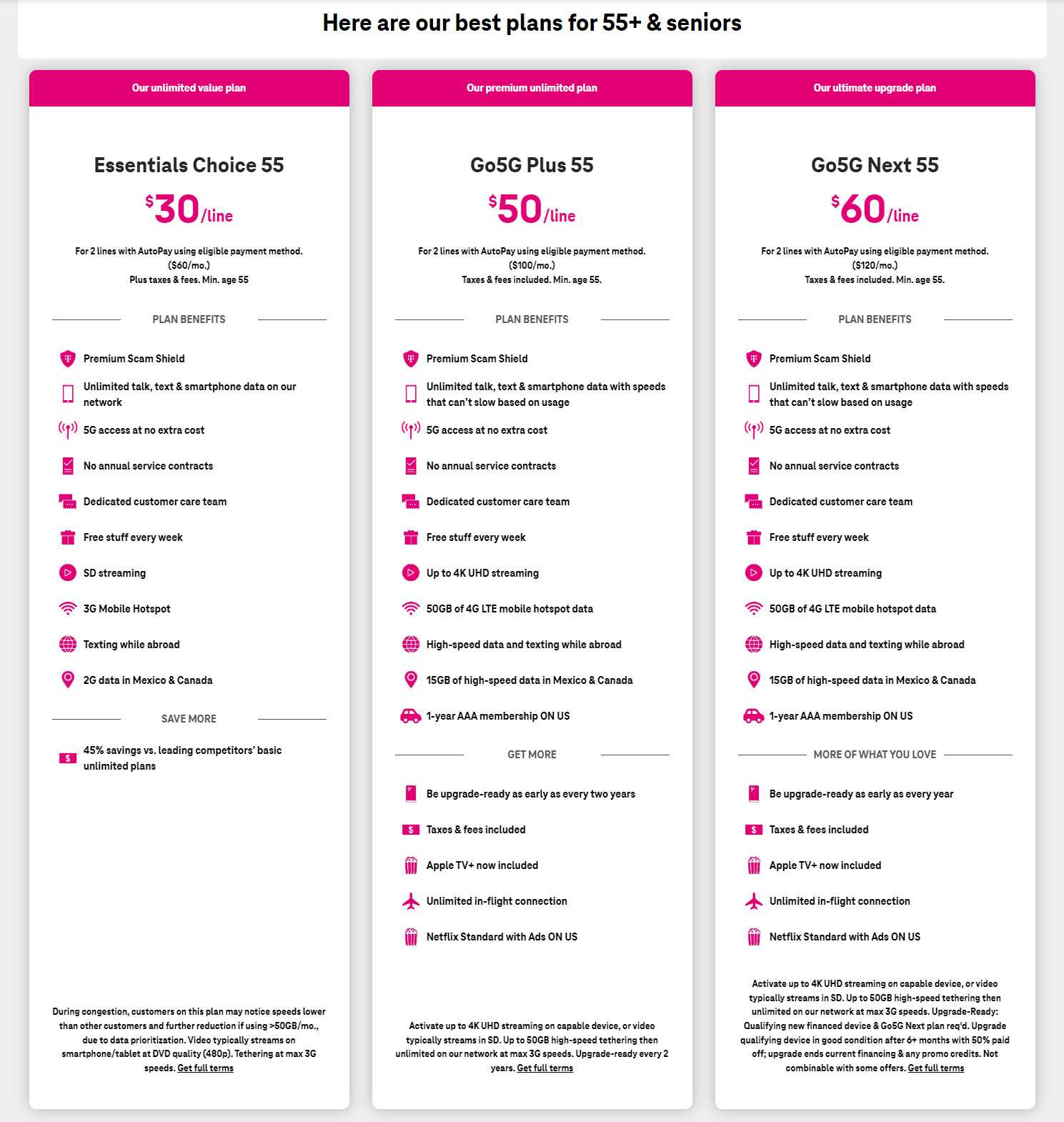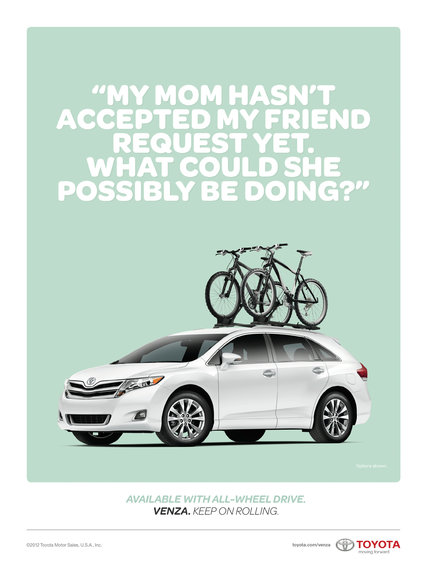For years, many of the world’s biggest brands have focused on Millennials. More recently, brands have shifted their sights to targeting Gen Z, aiming to make lifelong customers out of its members. But a few companies have taken a different approach. With Baby Boomers retaining their spending power and increasing their spending while younger generations cut back, a handful of brands have spotted the opportunities that marketing to Baby Boomers offers and are adapting their strategies accordingly.
You can apply these same strategies when marketing to Baby Boomers in the senior living industry.
1. Tailor Your Product to Meet Their Needs (T-Mobile)
T-Mobile’s strategy for marketing to Baby Boomers and tailoring their products to meet their needs may have you questioning whether you really understand what consumers ages 55 and above really want in a product.
Their suite of plan offerings has a specific subset geared exclusively to the 55+ crowd, with positioning that focuses on benefits more likely to speak to the audience, like scam protection, dedicated customer care team and texting while abroad.
The plan options come with access to the latest smartphone models — a far cry from the obsolete flip phones with big buttons and limited-minute plans that competitors tout as specially made for seniors.


A quick peek at the positioning of T-Mobile’s standard plans reveals big differences, with a much smaller font size and focus on upgrade availability, streaming capabilities and flexibility of use as a mobile hotspot.
Sometimes it can be easy to confuse what you think consumers want with what they actually want. (Or worse, simply follow your competitors’ approach!) That’s why, on many occasions, the best solution is the simplest one: Ask them. That’s what we always recommend to our clients.
Whenever a client is considering an expansion, we always recommend conducting surveys and focus groups so that they can hear directly from the customer about their wants and needs. It’s during these moments that you’ll discover what your customers’ must-haves are, as well as the non-negotiables that will turn them away from your offering. (With the right approach, you can even turn those early research groups into depositors and brand advocates with valuable referrals!)
As T-Mobile’s former CEO John Legere put it, “This generation deserves a little respect!” He’s right — and it’s time marketers started giving it to them.

2. Cater to Their Aspirations (Toyota)
Toyota has a long history of marketing to Baby Boomers, who were the focus of the “Keep on Rolling” ad, which first aired in 2011. The commercial features an adult child commenting on her parents’ inactivity on social media while her parents are out engaging in the activities they love (in this case, mountain biking with friends).
The ad speaks to the aspirations of older consumers. The couple continues to be active as they age, and members of this demographic viewing the commercial likely want to live in a similar manner for as long as possible — this ad just reinforces that desire. In the ad, Boomers aren’t portrayed as old, stagnant or technologically inept. It’s the adult child who is portrayed as living in somewhat of a distorted reality and lost in the world of social media.
At Creating Results, we believe one of the flaws of generational marketing is the notion that one generation must be knocked down to elevate another one. With that said, the ad did make us want to take another look at how the senior living industry is marketing to Baby Boomers.
Many ads are still overly clinical, depict seniors as inactive or include copy or imagery that doesn’t align with the customer’s aspirations. Think about some of the activities that residents at your community participate in or those of the demographic you want to target. We have clients whose residents enjoy swimming, hiking, biking and more. We make sure to depict these types of activities in ads for our clients when marketing to Baby Boomers to show that they can continue pursuing their interests and engaging in active living at a senior living or 55+ community. We’d recommend the same approach to any marketer in the industry: Use lifestyle to appeal to the customer.
Today, Toyota continues to invest in features that will benefit older adults as they age. In 2020, the brand broke ground on “Woven City,” to test new mobility technology, like robots, wheelchairs, autonomous vehicles and scooters, among the city’s population.
Toyota also partners with May Mobility, which launched Arizona’s first on-demand autonomous public transit service for residents of Sun City, a 55+ community. May Mobility will continue to scale the program through 2024.
3. Create a Pleasant Purchasing Experience (John Lewis)
You’ll notice the unique look of John Lewis’ website right away. It targets multiple generations, but seamlessly blends models of varying ages, which is particularly apparent in its women’s section, which has featured 60+ models in modern, ageless fashions for more than 5 years. It’s so unusual to see that it really makes you stop and look more closely. The brand earns points with Boomers is for its exemplary staff and service, ease of shopping and clear brand values.
Your content goes here. Edit or remove this text inline or in the module Content settings. You can also style every aspect of this content in the module Design settings and even apply custom CSS to this text in the module Advanced settings.
Think about the experience you’re creating for your customer. Are you hiding prices and making your customer provide their personal details to access basic information about your community? Our research has found that these types of practices are a deterrent for customers. Doing so makes it harder for them to learn about your product and easier for them to eliminate you from consideration.
While we’re not against keeping some items behind a gate until a form is filled out, we recommend reserving this approach for cornerstone content, such as in-depth guides offering value the mature consumer won’t get elsewhere.
Also consider the people who act as the faces of your brand. For 55+ and senior living communities, the members of the sales team are responsible for nurturing the relationship between the brand and the customer. Long wait times, unreturned calls, inaccurate information and other elements of poor customer service won’t win you any fans. That’s why it’s important to have a well-trained sales team that prioritizes the customer over the sale and can communicate how the brand’s offerings align with the customer’s wants and needs.
4. Innovate, But Don’t Eliminate When Marketing to Baby Boomers (Geico)
For the past 25 years, Geico has mastered the art of storytelling. After introducing the Geico Gecko® in 1999, in partnership with their longstanding agency, The Martin Agency, the lovable mascot quickly became one of the most recognized cartoon mascots in the U.S. The brand used the Gecko to tell their story, amassing nearly 2 million followers and 140 million views on YouTube.
This year, Geico honored the Gecko’s long tenure by developing a 15-minute mock documentary on his origin story, Legend of the Lizard — which debuted during the Super Bowl to wild success.



